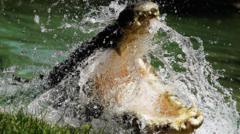As dawn breaks over Darwin Harbour, Australia, government ranger Kelly Ewin skillfully balances on a floating crocodile trap, readying to catch one of the region's infamous saltwater crocodiles. The Northern Territory (NT), home to approximately 100,000 of these reptiles, is an area well known for its proximity to both humans and these apex predators. With dangerous storms looming overhead, Ewin remarks, "You get pretty much zero chances with these guys," as he carefully approaches the agitated creature.
Six decades ago, saltwater crocs faced near extinction due to rampant hunting. However, since the hunting ban in 1971, their population has rebounded dramatically, prompting a new challenge: managing their numbers to ensure public safety. Crocodile expert Professor Grahame Webb highlights the potential backlash from the public if crocodile populations are not kept in check.
The NT’s harsh climatic conditions and abundant waterways provide ideal habitats for these cold-blooded reptiles. While fatalities from crocodile attacks are rare, incidents still occur, reigniting discussions about how to coexist with such potentially dangerous wildlife. Last year, a tragic incident involving a young child underscored the balance between human presence and crocodile habitats in the area.
To mitigate risks, Ewin and his team regularly check 24 traps around Darwin, removing crocodiles that pose threats to locals. Crucially, public education programs like "Be Crocwise" teach responsible behavior around waterways, proving effective enough that other regions, including Florida and the Philippines, are seeking to implement similar strategies.
The NT government recently approved an extensive crocodile management plan increasing the annual quota of crocodiles that can be culled. However, mass culling remains off the table due to the species' protected status. Alongside management efforts, the crocodile industry has emerged as a significant economic factor, with luxury fashion brands investing in crocodile skins, driving sustainable practices.
Despite differing viewpoints, a consensus grows around the idea of cohabitation. Crocodile farming, which arose after hunting restrictions, is increasingly seen as a path toward conservation that also provides financial opportunity for local Aboriginal communities. The effort to balance the rights and customs of traditional owners with modern economic viability is unfolding continuously.
Concerns persist, however, as animal rights activists voice objections about the treatment of captive crocodiles, emphasizing their social nature versus the reality of solitary confinement in farms. As the dialogue continues on the management of saltwater crocodiles, the specter of human-crocodile interactions remains potent. As Professor Webb famously summarizes, swimming near known crocodile habitats carries a significant risk—one that both the local population and authorities must navigate as they tailor their approach to coexistence in this complex ecosystem.






















